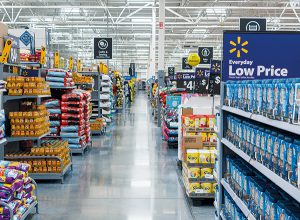Even as the world braces for recession, the big consumer groups, including Coca-Cola Co, Nestle SA and Unilever Plc, beat expectations and raised their sales guidance this earnings season. It seems many shoppers were prepared to pay more for their products. Yet this optimism flew in the face of an earlier warning about the sector: Walmart Inc, a bellwether for the US consumer, issued a profit warning.
So what’s going on? The simple answer is, we must all still buy food, but we can easily jettison non-essentials such as clothing, cushions and even electronics. That’s hurting Walmart and Best Buy Co, which also cut its sales and profit outlook.
Those packaging our coffee and making our dish soap aren’t yet hurting as badly, but Walmart’s pain could still spread. A broader reckoning from inflation will be hard to escape.
Walmart, known for its low prices, may be gaining grocery shoppers, as some wealthier consumers trade down — a phenomenon that is also being seen at McDonalds Corp and Chipotle Mexican Grill Inc. The retailer actually raised its forecast for second-quarter US same-store sales growth, excluding fuel, to 6% from 4%-5%. But this can’t make up for what it’s losing in the more profitable general merchandise category.
Just over half of what Walmart sold last year was not food, according to GlobalData. That includes household essentials, but also more discretionary items such as clothing. As less affluent shoppers are having to spend more on food and fuel, they’re cutting back on sweatpants and sneakers, which the company had stocked up on amid the supply-chain snarl-ups of late last year. Target Corp is even more exposed to nice-to-have categories, with only 20% of its sales coming from food last year. Even its more upmarket customer base couldn’t save it from two profit warnings.
Other changes in shopping habits are only adding to retailers’ strain.
Higher prices should inflate the value of sales at supermarkets. But shoppers are “dialing out inflation†from their carts, by switching from expensive types of protein to cheaper ones and swapping household names for private labels. With meat prices rising, for example, Americans might be ditching the steak and opting for hot dogs and burgers instead.
Private labels are more profitable for retailers than branded goods, but other types of trading down aren’t so helpful: Supermarkets still incur the same staffing costs from selling a burger as from a steak.
It’s also possible that Walmart isn’t passing its own price pressures onto customers in full. After all, it must be conscious of losing them to the growing German discount retailers Aldi and Lidl, as well as to the dollar stores.
Even though consumer goods groups sell essential items, they are grappling with rising costs for raw materials. These haven’t yet peaked, although there are some signs of stabilisation in grain and palm oil prices. However, they have been able to raise their prices in the first half of the year — to the tune of almost 10% in North America and almost 5% in Europe in the case of Nestle. So far, more customers have absorbed the hikes than have dialed them out, hence the spate of sales upgrades across the industry.
But it is notable that although companies including Coca-Cola, Kraft Heinz Co, Nestle and Unilever lifted their sales forecasts, in most cases this hasn’t been matched by upward margin revisions. In other words, they may be selling more, but those sales are not necessarily more profitable.
More customers could also start resisting price rises, which are set to continue in the second half of 2022, although perhaps not at quite the same pace. We are at a point where shoppers are really starting to feel the frequent, incremental uplifts in what they pay for everyday items. In the year to July 10, US private-label sales rose 7.5%, compared with growth of 5.5% for national brands, according to data provider IRI. It is a similar picture in western Europe, where private label’s share of spending is expanding ahead of household names, according to NielsenIQ.
All of the big manufacturers are acutely aware of the dangers. They are stepping up marketing to counteract the threat, another factor weighing on margins.
Other signals that volumes may be weakening include a ramp-up in promotions to turbocharge sales volumes. This is exactly what happened the last time prices rose significantly a decade ago, and will be worth watching this time round.
If shoppers don’t keep buying as many cans of Coca Cola, packs of Kraft Lunchables and Nespresso coffee capsules, the situation at Walmart could be a preview of what’s to come everywhere else.
—Bloomberg
Andrea Felsted is a Bloomberg Opinion columnist covering consumer goods and the retail industry. Previously, she was a reporter for the Financial Times
 The Gulf Time Newspaper One of the finest business newspapers in the UAE brought to you by our professional writers and editors.
The Gulf Time Newspaper One of the finest business newspapers in the UAE brought to you by our professional writers and editors.

